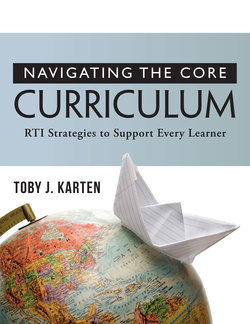Читать книгу Navigating the Core Curriculum - Toby J. Karten - Страница 6
На сайте Литреса книга снята с продажи.
ОглавлениеTABLE OF CONTENTS
Reproducible pages are in italics.
ABOUT THE AUTHOR
INTRODUCTION
Response to Intervention
Systematic and Explicit Instruction
The Four Cs of RTI
Core Knowledge
Structure of This Book
CHAPTER 1
OPENING DOORS FOR ALL LEARNERS
RTI Variables
Classroom Dynamics
Teacher Expertise
Evidence-Based Practice
Cohesive Framework
Prescriptive and Responsive Instruction
Contextually Engaging Tasks
Multiple Curriculum Entry Points
Successful Strategies and Mindsets
MTSS Lesson Connections
Conclusion
CHAPTER 2
APPROACHING THE CORE VOCABULARY
Academic Language
Identify Vocabulary for Students With and Without IEPs
Determine Student Levels
Select Appropriate Interventions
Evidence-Based Practice
Vocabulary Instruction
Early Literacy Skills
Multiple Curriculum Entry Points
How to Identify Knowledge, Intervene, and Ensure Internalization
MTSS Lesson Connections
Conclusion
Phonemic Awareness and Fluency Record
Comprehension of Fiction, Narrative, and Expository Text
A–Z Vocabulary List
PRO-Vocabulary Instruction
CHAPTER 3
CREATING TIERED INTERVENTIONS FOR LITERACY AND MATHEMATICS
The Spectrum
Academic Levels
Interests
Motivation
Evidence-Based Practice
RTI-MTSS
Differentiated Instruction
Universal Design for Learning
Multiple Curriculum Entry Points
Step-by-Step Task Analysis
MTSS Lesson Connections
Overlearning and Automaticity
Conclusion
Interests and Strengths Questionnaire
Tiered UDL-MTSS Literacy Planner
Lesson-Planning Template: Learner Outcomes and Skills
CHAPTER 4
IMPLEMENTING BEST PRACTICES
The Big Ideas
Literacy and Mathematics Achievements
Interventions, Accommodations, and Modifications
Multitiered System of Supports
Evidence-Based Practice
Strategic Reading and Writing Fluency
Learning Environments
Behavior
Assessment Data
Multiple Curriculum Entry Points
MTSS Lesson Connections
Learner Outcomes
Conclusion
Parts of a Book
Syllable Types
Words and Questions Chart
People, Places, and Things Chart
Record of Mathematics Skills, Concepts, and Engagements
Record of Student Participation
Reading Reflection Chart
Written Expression Chart
Lesson-Planning Template: Lessons Across the Disciplines
Curriculum Dice Game
CHAPTER 5
OFFERING ACADEMIC AND BEHAVIORAL SUPPORT
Respect for Learner Variability
Student-Specific Tiers
Collaborative Problem-Solving Approach
Evidence-Based Practice
Support for Academic Achievements
Positive Behavior Interventions and Supports
Attention and Cooperation
Multiple Curriculum Entry Points
Visual, Auditory, and Kinesthetic/Tactile Approaches
MTSS Lesson Connections
Conclusion
My Behavior Chart
Problem-Solving Approach: Turning Challenge Into Growth
CHAPTER 6
MINIMIZING AND MAXIMIZING STRATEGIC ENGAGEMENTS FOR RIGOROUS LEARNING
Challenge and Engage
Minimize and Maximize
Pace, Repeat, and Enrich
Fine-Tune and Individualize
Evidence-Based Practice
Cognitive Strategy Instruction
Triarchic Theory of Intelligence
Direct Instruction
Cooperative Learning
Peer Supports
Multiple Curriculum Entry Points
Real-World Connections
Strategic Engagements
Conclusion
KWL Chart
Quarterly Lesson Planner
Long-Range Monthly Planner
CHAPTER 7
ENSURING PROFESSIONAL FIDELITY
Professional Development
Preparation and Sustainability
Conclusion
Parameters for Professional Development
EPILOGUE
EMBRACING RTI
REFERENCES AND RESOURCES
INDEX
